Raising ducks in the homestead or on a farm is not a new idea. Hence, people are raising them from ancient ages as domestic animals. Because duck farming is easy & profitable. Even a beginner can become a successful duck farmer.
Now if you are a beginner and want to start duck farming from scratch, read through this a to z guide. I will be discussing everything you need to know about the duck farm, raising them for meat and eggs to making money.
A duck farming industry may be started, operated, and profited by reading this tutorial. This complete guideline will discuss how to grow ducklings and breed maintenance in commercial duck farming.
So, let’s dig in…
Duck Farming- Everything You Need to Know
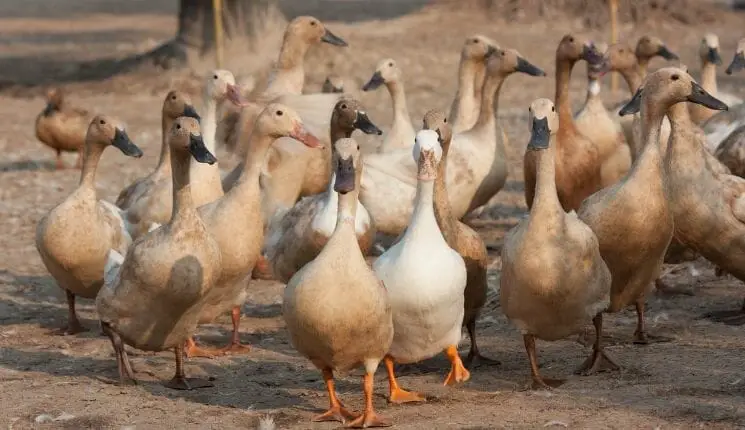
As the world’s population grows, so does the need for food. To meet this need and make money, people are engaged in a variety of food manufacturing businesses.
Duck farming is undoubtedly a profitable business field. Additionally, it will also assist to minimize food shortages.
However, it is necessary to provide ducks with housing that is simple and less costly. Therefore, you can start duck farming businesses with a little budget.
What is Duck farming? A farmers Prospective
Duck farming is also known as duckery farming — is a process where ducks become a part of the poultry farming sector and are then being bred and raised.
As a result, there is a distinct difference between duck farming and poultry farming.
The difference is mainly in terms of shelter, habit, and growing procedure. Meat and eggs may be obtained from ducks. And many people grow them up for this reason.
However, duck is second only to chicken in egg and meat production throughout most of the world’s regions.
Commercial duck farming seems to be on the rise, as egg supply has high profit potential.
In comparison to hens, ducklings are more resilient and can adjust to severe weather conditions.
Ducks can even live on agro-industrial leftovers and swamps. They can also live in marshy regions.
Therefore, commercial duck breeding is an opportunity for many people out there as it is not that difficult to start with.
Why Consider Duckery Farm Business?
Interestingly ducks can also thrive in places where no other crops or cattle can be cultivated.
It is an undeniable fact that duck farming is a lucrative and successful business.
Raising ducks takes you less effort since there are many different breeds of ducks accessible across the world.
You should have availability to just a water supply to grow ducks for egg production as well as breeding.
Even though ducks can live without water, they require a water pond to lay viable eggs and reproduce. If you want to raise commercial ducks, you’ll need to construct a pond.
The entire process needs steps to follow but at the end of the day, you will be benefitted. You will be able to make a good profit out of this business.
Benefits of Duck Farming
Running a duck farming business has many benefits. Ducks are second only to chickens in meat and egg production throughout many nations.
Let’s see how to duck farming brings different advantages! Listed below are a few of the most prominent benefits of duck rearing or farming.
- Requires Low Initial Investment: For the housing, such birds may thrive in huts built of locally accessible materials without the need for pricey shelter. Duck houses may be constructed mostly from low-cost components.
- Low Maintanence Required: Ducks are resilient birds that require little maintenance. They can adapt to a wide range of ecological conditions and situations. This is a resilient animal that can be reared in any environment. Women and older people may run a duck farm without any issues, as long as they are willing to learn. It requires far less special care as well as maintenance than just about any other poultry bird.
- Commertially Demandable: Ducks may be bred for meat and eggs on a commercial and limited scale basis. They lay eggs exclusively throughout the early morning and at night, and in the rear cases throughout the day. The collecting of eggs does not require any particular care.
- Extreme Survivability: Compared to hens, ducks live much longer and then have a lower mortality rate. During the egg-laying season, ducks lay eggs for a prolonged period. It is possible to raise ducks in your garden in conjunction with certain other birds and animals.
- Less Hassle While Collecting Eggs: Ducks tend to lay eggs at night or even in the morning. So, every morning, you may get their fresh eggs. Even during the day, you may go about your other duties without worrying about attending to your ducks.
- Reuire Less Area: Compared to rearing chickens, keeping ducks requires less amount of area. Compared to chickens, ducks have quite a shorter incubation period, hence ducklings grow and mature more quickly.
- Fast Growing: Ducklings develop so quickly that external heating may be applied within 5 to 7 days. Mostly during the winter months, they would take a much longer heating duration.
- Easy Food Habbit: Ducks may be fed a broad range of foods. Ducks eat cassava, copra, corn, grains, fruits, as well as many more low-cost and conveniently accessible foods. Using ducks to reduce apple snails or other pests in your garden is also an option.
- Profitiability: Eggs and meat from ducks are in high demand on the local and global markets. Duck farm can be a rewarding enterprise. There are still many successful and established duck owners who have been earning a good profit. Duck farming may be a reliable source of employment. In this firm, educated and intelligent unemployed young people can also find work or raise their own business.
Duck Farming as Profitable Business
“Is duck farming profitable?“
Years after years, many corporate farms grow millions of ducks for their flesh and eggs. It is indeed easy to picture what occurs on duck farms throughout the globe.
For instance, we can take the example of Reichardt Duck Farm. Which got popularized by DxE’s recent Right to the Rescue mission. It has been found that the farm slaughters nearly a million ducks and all on its own.
“High-ticket” “products” including duck eggs and meat are the main reasons for which farmers get engaged in the duck business. They jump into that work to make a rapid profit. So, there is no doubt that
Duck farming is regarded as a luxury or delicacy which comes with a hefty price charge for the buyers.
Duck Farming Business Plan
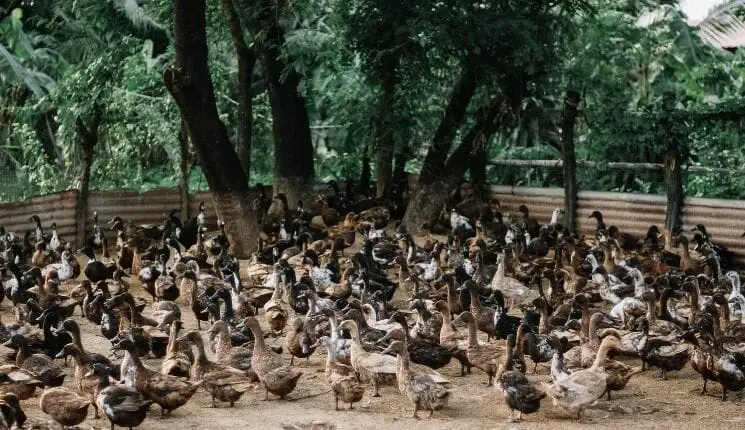
Duck farming is a quick, simple, and straightforward business to start. The process of starting a commercial or small-scale operation is quite straightforward.
Before you begin commercial manufacturing, seek out instruction from such an institute or an expert that are trustworthy. To operate your firm successfully, you’ll need a comprehensive training program or may follow the instruction of this article.
If you are a beginner, you can still start raising ducks. A profitable and profitable duck farming company requires a lot of knowledge from identifying breeds to maintaining for and selling them.
Duck Farming Methods
Over a long period, Viet Nam’s duck farming methods have evolved, and they now serve a vital role in supplying money for local producers and food for the human race.
It is important for all of the farmers who want to start duck farming in near future. Not all the methods are suitable for all the business people.
If you know the methods and their differences well, then you will be able to find out the most suitable one for you from here. Let’s dig in more to have insights into the three amazing duck farming methods.
1. Free-grazing scavenging systems
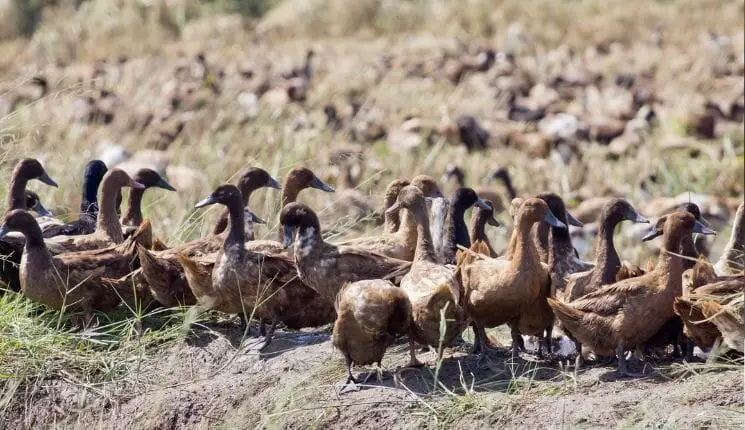
Growing rice supply both for use and trade has been emphasized in recent times. In the Mekong Delta, a basic rice-and-duck system is still widely used as a conventional combined duck rearing method. This technique involves ducks foraging in paddy fields till the rice reaches to flowering stage.
Ducks fight against insects, pests, as well as excrete fertilizers. So, rice yields remain remarkably constant, while synthetic fertilizers and pesticides are lowered or even removed.
Normally, immature rice plants are plagued by bug and golden-snail pests. Growers also discharge 200–400 ducklings or even up to 3000 laying ducks in the fields following the harvest to forage for remaining rice, pests, worms, and weeds, based on the current traditional approach.
Using their conventional expertise and knowledge, producers in rural regions nurture duck eggs in modest hatcheries, with each hatchery producing up to a million eggs yearly.
As far as localized breeds are involved, Tau ducks, which have since been domesticated and bred in the nation for a long period, seem to be the most significant ones.
Exotic breeds, such as Khaki Campbell and Chinese laying ducks, including unspecified crossbreeds are just the second most common in this list.
In rural regions, farmers construct tiny hatcheries for incubating duck eggs, potentially up to one million eggs produced annually per hatchery. And they tend to use their traditional skills and understanding.
The scavenging method is geographically focused on the villages in which the duck farmers dwell; the ducks are allowed to go into the fields whenever the irrigated paddy is harvested and collected.
Once natural feed sources including surplus rice are depleted in one area, the flocks are often relocated to certain other districts, and maybe even provinces, in the Delta, in which they forage inside the fields for food. Numerous rice types are grown in the Delta, including particularly high, fast-maturing types grown in various ecological regions.
2. Confinement system
This is a typical practice in the Mekong Delta for raising exotic and uncommon ducks and fattening meat ducks during dry weather.
When the fields are dry, flocks of 200–400 ducklings are housed in isolation to gain weight.
This technique, on the other hand, cannot compete economically with both the scavenging system.
Even though scavenge meat ducks are mostly taken and caged for completing about two weeks preceding the slaughtering.
On each farm, breeding ducks supplied from the United Kingdom as well as their cross-breeds are reared in captivity alongside fish.
3. Integrated poultry-based systems

For the proper hatching of ducklings, producers often use a combination of conventional procedures as well as incubators. Marketing the ducklings demand a large initial investment and a high level of understanding.
Since illnesses like AI, duck plague, or pasteurellosis are widespread in the Delta, the method is appropriate for breeders to utilize. It has been a gradual process over the previous ten years.
Moreover, to have meat or eggs for domestic use or financial gain, rural families maintain hybrid flocks of 5–50 typical and Muscovy ducks separately or along with hens.
Water plants, kitchen trash, and whole rice or rice by-products are used as local feeds to enhance the diet.
As a result of this method of duck breeding, the existing rural manpower is effectively used and the profit of impoverished farmers. Especially landless growers are increased. Yards, gardens, backyards, or adjacent canals and lakes, as well as local garbage well as commercial by-products, are the major components of the system.
As a result of the system, items are available for home use or are sold locally for a modest amount of money.
Agriculture and livestock systems that are designed to optimize production must take into account both natural resources and the socio-economic context to be successful.
Developing ecologically sustainable, low-input farming methods to maximize the productivity of natural resource management, reduce rural poverty, achieve food security are important parts of it.
Moreover, enhancing business, environmental and sociological aspects are indeed the goals of sustainable crop–animal systems development. Integration methods might enhance poultry and fish productivity and reduce land, labor, and water needs.
“Carbon management” refers to the input of soft, clean duck droppings to the duck–fish system as just a supplier of nutritional value for both fish and ducks.
Freshwater access, as well as parasite-free environments, make the duck-fish combination system extremely advantageous. The ducks’ feather texture improves mainly as a result of access to water in fish ponds.
Farm Size
Having a sound knowledge about the farm size is very important. It is mainly determined by the number of ducks you will keep on the farm.
Larger commercial operations may have 50,000 to 100,000 ducks in every batch, whereas smaller farms may only have 6,000 ducks per batch.
Larger commercial operations may have 50,000 to 100,000 ducks in every batch, whereas smaller farms may only have 6,000 ducks per batch.
Breed Selection
It is the second most crucial part. Your entire process depends on the type of breed you will choose. You must decide whether you prefer to raise ducks for eggs or meat. Go for the breed selection in accordance with this.
Determining the gender of a duck
Identifying the gender of a newborn duckling isn’t difficult. As the duckling’s tail is raised, press down on its rear end with your thumb. If you see a penis-like thorn, then it’s surely a male duck. Otherwise, this will be a female duck.
It is easy to identify male ducks by their tails. The curved tail feathers of male ducks are indeed the easiest sign or thing to identify male ducks.
Duck breeds to avoid
You must first choose the right breeds for your business. Around the world, there have been several different duck breeds to choose from.
Raising Ducks for Meats
Meat-producing duck breeds include a wide variety of varieties. Meat production is particularly popular with Peking, Ayleshbari, Maskovi, Ruel Kagua, and Sweden ducks. Male ducks that can produce meat weigh approximately around 5 kg, while female ducks weigh roughly 4 kg. Best ducks for meat are listed below:
- Pekin
- Cayuga
- Aylesbury
- Silver Appleyard
- Khaki Campbell
- Rouen
- Saxony
- Swedish Blue
- Buff Orpington
- Swedish Yellow
- Crested
- Grass
Raising Ducks for Eggs
Indian Runner ducks are a popular breed of layer ducks. They are well-known for their high egg production. Indian runner ducks come in three varieties. Runners in shades of white and gray seem to be ideal choices as good layers. This duck breed is also known for its excellent egg output. Best ducks for eggs are:
- Pekin
- Khaki Campbell
- Welsh Harlequin
- Indian Runner
- East Indie
- Abacot Ranger
- Alabio
- Call
- Buff Orpington
- Rouen
- Magpie
- Ancona
- Hook Bill
- Shetland
- Bali
Breeds of Ducks for Both Meat and Egg
For both meat and eggs, Khaki Campbell ducks are indeed a good choice. They were from Indian Runner and Ruel Kagua, two Native American tribes. India’s first runner is known for its egg production, while its second runner has been known for its meat production. Ducks suitable for both egg and meat are:
- Khaki Campbell
- Ruel Kagua
- Indian Runner
Investment of Capital
As a third step, determine the capital investment and development costs associated with the duck industry.
The total costing also includes the cost of the home and the area as well as the cost of purchasing the ducklings, feeding, and medications.
Profit
Modern-day farming is profitable. If you are just starting a duckery farm then you might decide how you are going to make money.
There are several to consider to ensure a good profit.
- Make sure to research local deamand.
- Find out the months when the demand is high or low.
- Market analysis is also a plus, it will help you determing which breed to choose.
Special Considerations
- It is recommended that poultry farmers grow just one variety of poultry to avoid the spread of HPAI H5N1.
Breeders of poultry, particularly ducks, must enroll with the appropriate agencies in their communities and agree to abide by the H5N1 restrictions of local officials. - The migration of scavenging ducks must be restricted, during the dry season, and all unauthorized duck flocks should then be eliminated without payment.
- A complete H5N1 vaccination of all ducks should be documented on the papers so that flock managers can be able to submit it to the local veterinarian when relocating the ducks.
- When relocating ducks to a different district or province, flock owners have to be able to show the local veterinary office immunization records.
- Poultry goods must only come from flocks that have already been vaccinated by the relevant agencies and verified by them.
- To avoid HPAI H5N1 from infecting ducks and transferring to other creatures including people, poultry farmers must be thoroughly taught.
- Farmers in all the regions should be provided with disease-free ducklings, initially at reduced costs.
- If feasible, free-grazing methods must be replaced with systems that can be controlled or at least reduced in danger of HPAI outbreaks. Examples include the duck-fish method or absolute isolation, and local feeds must be used wherever practical to decrease food prices.
- To minimize the number of birds sold live, tiny slaughterhouses should then be built in regions where duck, as well as chicken farming, is intensive.
Now, we have a business plan, lets dive into how you can start your duckery farm from scratch.
How to Start Duck Farming Business (Step By Step)
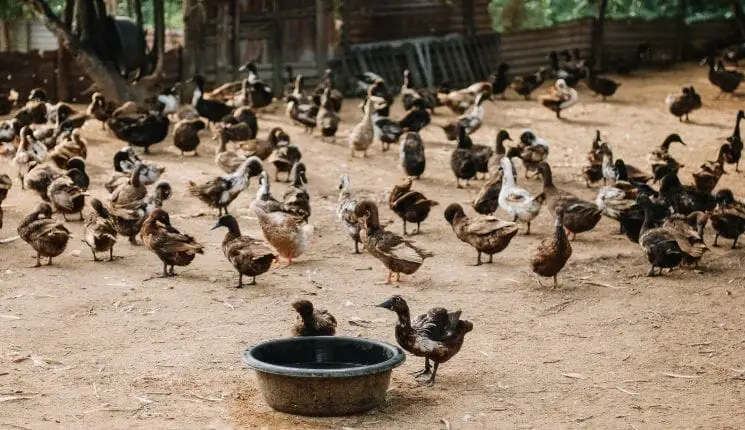
Duck farming is an easy and quick venture to start. Purely commercial or small-scale operations can be started easily. Duck farming’s biggest benefit is its simplicity.
In comparison to hens, ducklings are more resilient and can adjust to severe weather conditions. Ducks can even live on agro-industrial leftovers and swamps.
They can also live in marshy regions. Therefore, commercial duck breeding is an opportunity for many people out there as it is not that difficult to start with.
Consult with a reputable institute or specialist before beginning commercial manufacture.
You’ll just need to have a complete training program, and you may even just follow the instructions in this guide.
You may raise ducks even if you are a newbie. From recognizing breeds to caring for and selling them. However, a successful duck farming business takes a lot of knowledge. But don’t worry, I will tell you everything step by step.
Step 1: Pick a Breed
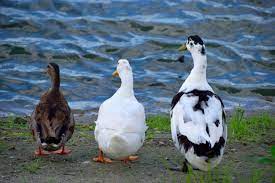
There are many varieties of ducks. Not all ducks can suit all types of farming. You will have to pick them wisely as most of them are incompatible with duck farming on a commercial scale
Egg production is possible with some breeds, whereas commercial meat production is possible with others. Ducks are generally divided into three categories based on their production and breeding process.
- Duck that produces a good amount of meat
- Ducks with a high egg production rate
- Ducks suitable for both meat and eggs
How to pick a breed depending on location?
Duck farming’s biggest benefit is its simplicity. Duck houses are incredibly simple to make and require very little equipment. It doesn’t matter if you maintain your ducks in a moderate, low, high, rainy, or dry location.
Ducks prefer to dwell in watery as well as moist or wet environments. To create an ideal home for ducklings out of a basket of fruit, wood-speech, or an oil barrel, follow these simple steps: These should be placed in a prominent location.
You should always have a door for ducks to enter and depart from wherever you store them. The door must be able to open fully. Because ducks raise their heads as they enter the home. Assure an adequate flow of fresh air within the house by properly ventilating and cleaning it.
Breeding
It is essential to have breeding water on hand during breeding. Ducks don’t usually mate without water. The reproduction of ten female ducklings can be accomplished with the help of one male duckling.
Five months is the average age at which high-quality and prolific duck breeds begin producing eggs. About 50 to 60 grams of the egg are included in each egg.
As an alternative to ducks, hens can be used to hatch the eggs instead. Newly hatched ducklings should not be kept in water during their first week.
It is essential to have breeding water on hand during breeding. Ducks do not even usually mate in the absence of water. The reproduction of ten female ducklings can be accomplished with the help of one male duckling.
Baby Duck or Adult Duck to Which one Pick?
Size is the main factor here. However, there are some characteristic differences noticeable between baby duck and adult duck.
Baby ducks do not have waterproofing feathers or the feathers like adult ducks. Therefore, they must be kept warm because they are a bit sensitive. The same thing has been true for baby ducks without a mother duck.
They cannot remain in the water for a longer period. Baby ducks are seemed to have different types of sound instead of quacking (girl ducks) or squeaking (drakes).
If the baby ducks fail to find their mother, they will get unhappy and agitated.
Older ducklings and ducks, on the other hand, are usually terrified of humans. Unlike adult ducks, baby ducks cannot fly. Baby ducks need special care and proper nutrition to grow well.
Step 2: Pick a Suitable Location
For the housing, such birds may thrive in huts built of locally accessible materials without the need for pricey shelter. Duck houses may be constructed mostly from low-cost components.
This is a resilient animal that can be reared in any environment, as we’ve already said. Women and older people may run a duck farm without any issues, as long as they are willing to learn. It requires far less special care as well as maintenance than just about any other poultry bird.
Ducks prefer to dwell in watery as well as moist or wet environments. To create an ideal home for ducklings out of a basket of fruit, wood-speech, or an oil barrel, follow these simple steps: These should be placed in a prominent location.
Before buying ducks, it is indeed ideal to even have the coop and run, as well as a water component and drainage system, fully built.
The time it takes to create a tiny duck home and run depends on how much support you get and your carpentry abilities.
You should always have a door for ducks to enter and depart from wherever you store them. The door must be able to open fully.
Because ducks raise their heads as they enter the home. Assure an adequate flow of fresh air within the house by properly ventilating and cleaning it.
Step 3: Build The Residence (House)

Duck farming’s biggest benefit is its simplicity. Duck houses are incredibly simple to make and require very little equipment. It doesn’t matter if you maintain your ducks in a moderate, low, high, rainy, or dry location.
Ducks prefer to dwell in watery as well as moist or wet environments. To create an ideal home for ducklings out of a basket of fruit, wood-speech, or an oil barrel, follow these simple steps: These should be placed in a prominent location.
You should always have a door for ducks to enter and depart from wherever you store them. The door must be able to open fully.
Because ducks raise their heads as they enter the home. Assure an adequate flow of fresh air within the house by properly ventilating and cleaning it.
You should keep the ducks away from their predators. For instance: the fox and dog, in particular, should be kept at a distance.
To maintain your duckling inside a concrete-floored home-like hen, you must dig a deep hole in the center of the housing.
Each duck will typically require 2 to 3 square feet of floor area to live comfortably. Your ducks’ safety must also be taken into consideration.
If you want to buy enough ducklings or older ducks to establish a full flock simultaneously, then the home – coop, and run must be large enough.
It should be sufficient to provide the ducks at least 4 square feet of mobility area (for matured size) while also accommodating a least one tiny plastic pool along with just multiple waterers.
Step 4: Learn Feed Management
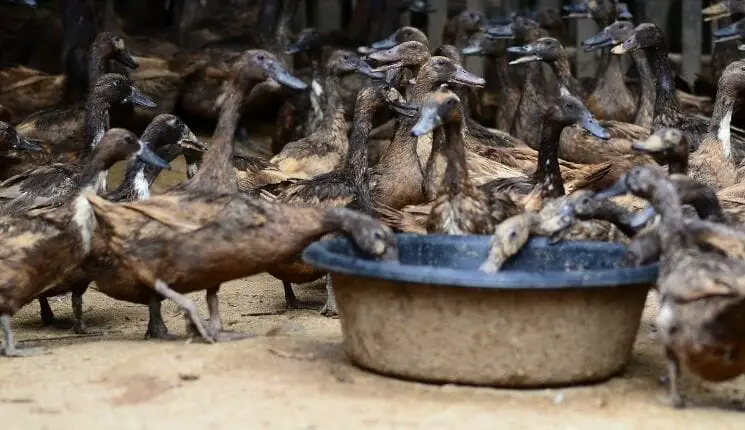
Ducks can eat a variety of foods. You do not need to spend a lot of money on feed. They live on bugs, snails, fungus, kitchen trash, rice, and other kitchen waste. These are its favorite food. Corn is a nutrient-rich feed source and ducks love it as well.
Ducks consume nearly any meal they can get their hands on. It is possible to feed your ducks in the same manner as you would feed chickens. Duck feed must, however, be supplemented with additional ingredients.
So, you must always be extremely careful when it comes to feeding your precious ducks. they need proper nutrition to grow in the right way. You should also include vital nutrients in their diets.
Quality of Feed
In most local feed stores, you may get commercially produced duck feed that is of good quality. Besides, feeding the duckling is different from the adults.
It may be less expensive for big duck operations to mix their own entire feed just on-farm rather than purchasing the food from a trustworthy commercial source.
As long as it is kept away from rats and insects, it will not get contaminated or moldy. Per year, a pair of rats may consume or contaminate more than 100 pounds of food.
For best results, just use feed within 3 weeks of the manufacturer’s date, or even sooner in warm and humid weather.
The foul-smelling or stale feed seems to be a sign of worsening and probable mold infestation, therefore it should be avoided.
Avoid using moldy feed, since certain molds generate toxins that might cause major health issues or stunted growth in your animal.
Mould toxin sensitivity is high in ducks. As an example, ducks are susceptible to aflatoxin concentrations as low as 30 ppb.
Ducks’ digestive system, liver, kidneys, muscles, and plumage can be damaged by mold toxins. They might also decrease development and reproductive function.
Qualitative factors like feed components are also crucial. You should not utilize moldy, weedy, or dirty grains.
Avoid utilizing outdated vitamin/mineral supplements that have been exposed to the sunlight or high temperature directly.
Type of the Feed
To enhance the growth rate and feed effectiveness of ducks, high-quality pelleted feed is always required.
The quality of a pelleted feed will degrade as the fines content increases. To reduce particles and increase pellet integrity, manufactured pellet binders are frequently employed. If you choose mash feed, ducks will develop around 10% slower than when provided pelleted feed, and the supply of waste will rise.
Ducks should indeed be fed a beginning diet from hatching until they are two weeks old, according to the American Duckling Association. The starting diet will be supplied as pellets or crumbles with a diameter of 1/8 of an inch (3.18mm). Following two weeks of age, start feeding a growing diet in the form of pellets with a diameter of 3/16 inches (4.76mm).
Water
It is recommended that under all circumstances ducklings should be provided with at least 1.5 linear inches of feeder’s capacity and 0.5 linear inches of waterer space. More room may be needed for larger ducks including the Muscovy.
The fact that ducks are waterfowl means that they are linked to water on an instinctual level. If indeed the waterer is just not constructed properly or kept at the right height, one such feature might produce a significant moist litter problem.
Throughout the event that ducks have been reared in captivity and then released into a water body, a water bath is useful for preening and keeping their plumage well-oiled. They’ll be able to float in a lake and hold their feathers in an excellent state this way.
Equipment for Feeding
A commercial non-toxic disinfectant should be used to clean and disinfect waterers at least three times per week.
Pour the rinse water into a bucket and take away that one from the pen instead of pouring it on the litter to help maintain a good, clean, and dry environment for the ducks.
The waterers and feeders should be checked regularly to ensure that they are operating correctly and not leaking or spilling liquids.
Ample floor, feeder, and waterer areas should be provided for young ducklings, due to their fast growth.
For the first three weeks, provide each duckling 2.0 square feet of wire space as well as 1.0 square feet of litter area. The floor space per duckling should be increased to 2.5 square feet after seven weeks if confined breeding is being used.
Necessary Micronutrients and Amounts
| Starter | Grower | Finisher | Breeder | Breeder2 | |
| Nutrient | 0-2 weeks | 2-6 weeks | 6-8 weeks | Developer | Layer |
| Metabolizable energy (kcal/lb)3 | 1,400 | 1,400 | 1400 | 1175 | 1300 |
| Protein % | 20.0 | 18.0 | 16.0 | 14.5 | 16.0 |
| Lysine % | 1.1 | 0.9 | 0.8 | 0.65 | 0.75 |
| Arginine, % | 1.1 | 10 | 0.9 | 0.7 | 0.85 |
| Methionine + cystine, % | 0.9 | 0.8 | 0.7 | 0.6 | 0.65 |
| Calcium, % | 0.9 | 0.8 | 0.8 | 0.7 | 2.9 |
| Available phosphorus, % | 0.45 | 0.4 | 0.4 | 0.35 | 0.35 |
| Linoleic acid, % | 1.0 | 1.0 | 1.0 | 0.8 | 1.0 |
Step 5: Healthy Duck Management for Profit
Ducks demand less space as well as less effort and time to brood. They also take less time for hatching.
As compared to other birds, ducklings develop much quicker than their counterparts. As a result, they take up much less space.
It is a robust bird that is resistant to many diseases. There are relatively few of these to be found. Several illnesses are prevalent in duck husbandry.
Fencing
Ducks should be protected from their predators. As a result, making a fence around its living place is mandatory. Make the fence strong and keep proper space for the movement of the ducks.
Cleaning the Coop:
Cleanliness is the root cause of a healthy lifestyle for any animal. This is the same for ducks as well. Always keep the house clean. Maintain a routine for cleaning the living place.
Changing the Beddings:
If the bedding is too dirty change it as early as possible. The dirty bed may infect them with different diseases. If you cannot change the entire bedding, then do change the upper portion for the time being.
Secure Health
Healthy ducks require a mix of adequate diet and proper care. To achieve the best health and developmental efficiency, commercially produced meals should be used. Animal predation is a problem when raising pet ducks on open lakes or waterways.
Turtles, owls, hawks, raccoons, skunks, opossums, cats, and dogs are just a few of the predators that may harm your duck flock. Keep your ducks in a predator-proof cage, if feasible. Identification of the predator is essential as predation has become an important issue.
Step 6: Care for Ducks
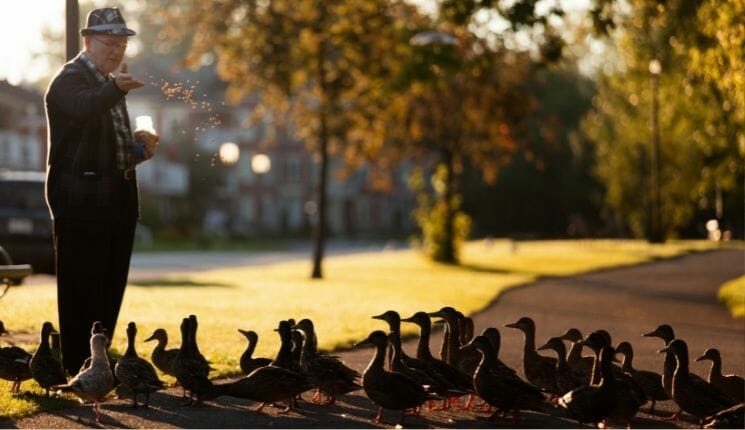
Ducks are easy and simple to raise. But they also require some care and time. Taking excellent care of your ducks is just as essential as feeding them well and providing them with a comfortable home.
Healthy development and long happy life for the ducks are ensured by proper care and handling. Always remain in touch with the local veterinarian to ensure they are properly immunized at the appropriate time. Let’s see some factors related to the caring of the ducks.
Winter Care:
Duck can survive 20 degrees F. That doesn’t mean that they will survive bad weather like Strome or cold breeze.
So you need to prepare your farm for winter. You should learn to keep ducks worm in winter. Also, ensure edible water.
This is crucial to secure their health and business profit.
Summer Care:
In general, if there are natural sources of water like lakes or ponds there is nothing to worry about. However, if the temperature is too hot (45 degrees F), then it will need extra care.
Moreover, on summer days when the sun produces more heat, and will make the surface and water hot.
So, they will require a shade to rest. Besides, at the night time, you should provide plenty of water in their housing.
Newborn Duckling Care:
Newborn ducklings are vulnerable to extreme weather. Besides, they will need extra care on food management and sheltering.
Here is what you should do to ensure duckling care.
- Seperare them from adults.
- Keep them in brooders for first 6-8 weeks.
- They do not need madicated feed like chicks, provide non madicated feeds.
- Ensure clean water.
- To keep them worm use a secure heat light.
- Provide dry baddings, change the frequently.
- Do not put them into water.
Treating Diseases
It has been shown that domestic ducks are more resistant to several illnesses and parasites than most domestic poultry. As a result, medicated duck feed is utilized less frequently than medicated chicken and turkey feeding. It is possible to use feed medicines to treat duck illnesses such as colibacillosis, poultry cholera, salmonellosis, necrotic enteritis, etc.
It is triggered by the bacteria, Escherichia coli and affects ducks in large numbers. By invading the yolk sac, E. coli might cause embryonic and duckling death. Most frequent are infections of the digestive tract and air sacs. Ducklings who are infected seem drooping and listless and seem to have diarrhea and eye discharge, among other symptoms.
It is transmitted by the bacteria Pasteurella multocida and affects domesticated ducks as well as other animals. A
s a result of their illness, sick ducklings avoid eating and vomit. It also causes them diarrhea. It is possible that mortality rates might reach as high as 50%.
A feed with 0.44 percent chlortetracycline (400 grams per ton) reduces mortality. Over five days, ducks that are affected must be given antibiotics.
A reduced calcium diet should indeed be given throughout the five-day course of treatment since chlortetracycline reacts to calcium in breeding feeds.
Step 7: Marketing
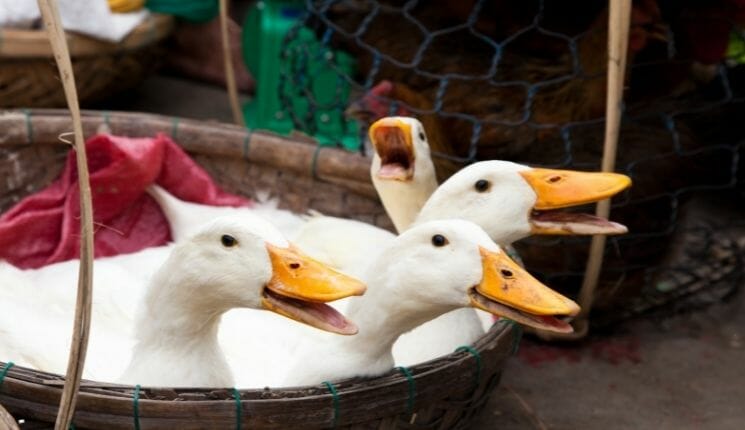
The marketing of duck goods (eggs and meat) is indeed a straightforward process. Since ancient times, duck eggs, as well as meat, have been enjoyed by people all around the world.
How to Store Eggs?
To keep the eggs fresh, you must store them appropriately. For egg storage, you might use a refrigerator. Eggs may indeed be stored in lime water or pyrazine. Some people sometimes use actinium glass water.
Tips for marketing your duck eggs and meat in proper ways
- Before going for marketing your duck eggs, wash the dirt of the eggshell properly. You do not need to clean the eggs with water. A knife, dirty paper, or towel should be used for cleaning the eggs. You can transport eggs in an egg basket or just a carton from one location to the next.
- If possible, select a cartoon that has at least 30 eggs in it. Eggs can also be transported to the marketplace or some other location using a bamboo basket, a wooden box, and certain other items. If you plan to store eggs in such a box, cover it with a thick layer of straw or rice bran.
- However, if you want to make the most money from duck farming, you’ll need to be extra cautious with the ducks, their feed, their housing, their breeding, and their marketing.
- Duck eggs and duck meat seem to be more popular in some places than chicken eggs or chicken meat. Duck eggs are bigger than chicken eggs and it is also a reason for getting advantage of it.
- Duck flesh is less common in certain regions than duck eggs. Marketing duck eggs and duck meat is just not loaded with difficulties. It is also easy if you know the trick.
- The potential for duck goods in your local market can be determined. It will help you to understand the liking of the people around you. Thus, you may proceed with the marketing.
- You may also do market research for knowing your target market and areas. It will help you to make a good profit within a short time.
Tips And Advice For Beginners
Tips on Infections and Vaccination
Ducks live in the wild zones and are generally self-sufficient. To domesticate ducks, you would need to build a coop and run.
To maintain them strong and healthy, certain duties can be done weekly or daily. When it comes to duck husbandry, even those who have raised poultry birds for a long period may not be prepared. Let’s see the most important tips and advice:
- For the pool splashing and muck, you need to prepare the ground accordingly. For this, you can put a layer of Gravel under the pool as well as surrounding it just by one foot. This facilitates faster draining. This will assist maintain the place clean and safe. For such ducks, the straw will also have to be supplied regularly.
- Hanging waterers with just a fountain element that hangs from the ceiling can help prevent a further mess. Ducks may also sip water from a cattle tub. A duck’s drinking waterer would spout water towards them. If they discover any water, they’ll dive in. If one is accessible, ducks may submerge their heads and necks in it.
- Disease resistance in ducks is widely known. For this reason, there are no documented immunization programs for ducks. Because they are regarded to be possible carriers of infectious illnesses from other animals. However, poultry farms are frequently kept apart from other flocks of birds. Certain broiler-related illnesses, such as coccidiosis and infectious bronchitis, are not quite as substantially significant in duck production. But you need to be always careful about their health and proper functioning.
- Due to their great sensitivity to toxins, ducks often fall victim to toxicosis, which is associated with high death rates. Botulinum toxin, lead, antibiotic abuse, and mycotoxins are some of the most prevalent reasons.
- Toxins in ducks have negative consequences that must be taken into account to prevent them. Quality standards of feed and raw ingredients should be conducted, and so should the inclusion of a mycotoxin agent in feeding composition.
- Duck breeding is troubled with locomotor issues. As a result of raising larger animals, lameness, dislocations, and shattered bones are typical occurrences in livestock. Animals with locomotive lesions may have reduced movement.
- Tibial dyschondroplasia including bacterial infections in the hocks are also typical issues associated with animal weight and reproductive health.
- Intensive reproduction can also result in additional issues, such as ascites, due to the animal’s fast growth rate. Animals develop ascites when there has been a disparity between their development and even the development of their heart and lungs, which prevents these organs from providing enough oxygen for the body.
- A potentially contagious illness of significant economic relevance, duck viral hepatitis (DVH) is a sickness that must be identified. Three varieties of duck hepatitis A virus, a picornavirus, are responsible for DVH. It should be kept in mind as well.
At last, it can be said that a biosecurity initiative is necessary to protect wild animals from coming into touch with the flock, feed, and drinking water.
It also includes a thorough cleaning and sanitizing of the facilities to avoid infectious diseases. It is indeed vital to minimize bringing animals of different ages into proximity.
Vaccination is advised when there has been a significant risk of contracting the infection. Due to their use, animals can enjoy a decent immune system and have an improved response to vaccination. This results in greater defense against illness and infection disorders.
Tips on Securing Healthey Egg Laying Process
Duck moms are noted to hide their eggs under their nests frequently. To safeguard the egg from predators, they cover it with the cage foundation.
- It is often used to preserve the egg warm during preparation. Rather than being concentrated in one place, the hiding spots are randomly distributed around the cage. This danger is typically overlooked by farmers who labor too rapidly.
- It is rare for a new farmer to know exactly how many male and female ducks must be housed in one cage.
- They could have thought that the more frequent men and females are introduced, the faster the reproduction would occur. Actually, the situation is not like that. The ratio amongst male and female ducks must match the cage.
- A large number of farmers do not even have enough idea about the optimal age for ducks to become pregnant and start producing eggs.
- Female ducklings are bred to deposit eggs as soon as possible to satisfy market demand, regardless of whether it is too early for them to get fertilized as well as lay eggs.
- A female duck’s genital organs and body are not ready when she is too young. Just like that, the female duck’s body is not suitable to lay eggs when she is too old.
- And this interferes with the egg production process. So, keep the timing and age into your considerations.
- Egg production is also affected by extreme temperatures. The duck’s anxiety level will be high in hot weather.
- While its ability to detect heat will be impaired in cold weather. Winter or summer, you must maintain a comfortable temperature.
In addition to understanding the quality of duck seeds, you must also be able to calculate accurately to optimize egg output. The relationship between the factors that contribute to egg production must be calculated down to the tiniest detail.
Trivial actions can lead to big issues, hence it is important to keep an eye on the little factors that impact the egg-laying procedure.
Whenever the egg-laying process starts, bacteria growth accelerates. Simple duck hygiene, as well as health, must be continued to improve. Whenever the seasons shift, it is indeed important to keep everything clean.
Frequently Asked Questions
Is duck farming profitable?
And then people slaughter these for their flesh. From the opinion of many producers, these creatures are ideal since they are gentle and easier to nurture.
So industrial farms develop to produce as many ducks as reasonably possible to maximize profits at the expense of the ducks’ health and stability. Duck farming is regarded as a luxury or delicacy which comes with a hefty price charge for the buyers.
Why Duck Farming is Unfair?
Ducks in the wild areas live in a healthier place and lead a natural life than the farm’s ones. In farms, the ducks live in dark, filthy, and confined conditions. It is not at all healthy and safe for them by any means.
There are some reasons for which some people think duck farming to be unfair work. Some reasons are mentioned below:
Lack of Water
Then, think of such a park or lakeside where you’ve noticed many beautiful ducks. Most of the time, they are seen either swimming, flying, or digging through the grass.
For a duck to be happy and healthy, it needs access to water, which factory farms restrict it.
Since they invest much of their lives in the natural on or near water, their bodies are just not designed to stay for lengthy stretches of time on rough surfaces. They are still forced to stand on a hard surface for weeks before being slaughtered.
Excrement buildup is a significant reason for infections and ailments in ducks’ eyeballs, skins, and lungs.
Dirty living Place
You may expect psychological as well as physical impact once you confine hundreds of birds inside a shed who might otherwise have the entire globe to fly.
The bedding materials used in the duck farms are typically not replaced throughout the process of reproduction. So, it results in ammonia formation. Laborers who visit barns are also affected by this foul stench, which causes their lungs to get inflamed.
As a result of their inability to self-clean, ducks are often more prone to infections and illness.
What is Integrated Rice and Duck Farming?
Inside an irrigated paddy field, rice and ducks are grown together. In addition, Duck paddling fosters plant development, and even the duck dung fertilizes the soil organically. Moreover, many insects and weeds are also eaten by the ducks. They are also minimizing the necessity for fertilizers, pesticides, and herbicides in the field.
How does rice duck farming work?
The duck-rice phase lasts around 6-8 weeks. The ducks will reach up and eat the grains mostly on rice plants as they start to plump out, therefore the flock must be eliminated before any of this stage. By this period, however, in early August, the plants will have grown a complete canopy over all the paddy, as well as weeds will no longer be such an issue. Ducks raised with incorporated duck rice provide a good supply of meat and eggs.
Why do some people think duck farming is unethical?
Ducks in the wild areas live in a healthier place and lead a natural life than the farm’s ones. In farms, the ducks live in dark, filthy, and confined conditions. It is not at all healthy and safe for them by any means.
Final Words:
Keeping ducks may be a beneficial and sometimes even profitable endeavor if you prepare ahead of time before acquiring the poultry birds.
Defy the desire to buy on the spur of the moment until you’ve done your homework. Just choose the appropriate breed and then keep going with the proper steps.
Make the finest living conditions for them beforehand. Make sure you understand how the ducks will indeed be treated.
Consider how much time it will take to provide regular care and attention for them. Before you decide on duck farming, consider the cost and other factors as well. Duck farming is quite easy when you do things accordingly, but it requires your time and effort for a long time.
